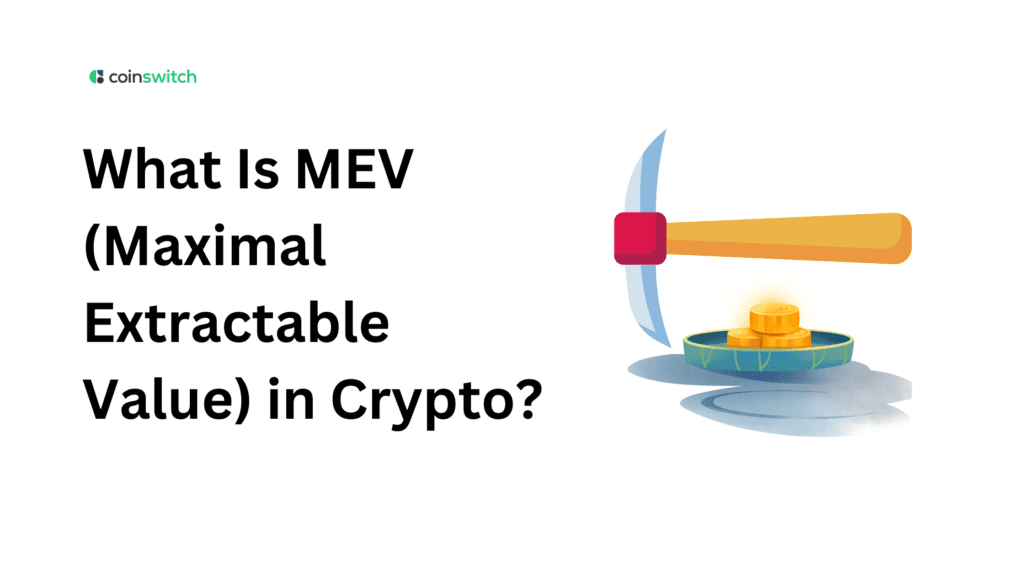Ever noticed how some crypto traders always seem one step ahead on the blockchain? Every swap you make, every token you bridge, someone’s watching, and profiting. That “someone” is often a bot, and the game it plays is called MEV. In the world of crypto, where decentralization reigns, MEV is one of those realities nobody can ignore. It lives in the mempool, thrives on speed, and moves faster than your transaction ever could.
Whether you’re a retail trader swapping tokens on a DEX or a developer building the next DeFi protocol, MEV affects your costs, your profits, and your assumptions about fairness.
Let’s unpack it.
What Is MEV?
MEV stands for Maximal Extractable Value. It refers to the maximum value miners or network validators can extract by rearranging and reordering transactions waiting to be added to the blockchain.
Here’s the twist: MEV doesn’t come from validating blocks. It comes from manipulating the order of transactions within a block. Validators don’t just validate; they curate the order in which things happen. And that order can create or erase value.
Imagine an NFT mint about to sell out. Your transaction is in the mempool. A bot sees it, copies it, pays a higher gas fee, and beats you to the mint. That’s a form of MEV. You paid for gas and got nothing.
Read More: What Is Fully Diluted Valuation (FDV) In Crypto?
How Does MEV Work?
It starts before your transaction hits the blockchain. When you click “swap” or “send,” your transaction is placed in a temporary waiting area, known as the mempool. This is where validators, bots, and MEV searchers hang out.
They scan these pending transactions in real time, looking for profit opportunities. That could mean:
- Front-running: When you place a transaction in a queue when you have knowledge of a future transaction.
- Back-running: Here, the miner places a lower-fee transaction just after a higher-paying one. Executing right after your trade to capture value.
- Sandwiching: In sandwiching, you place one order right before the trade and one right after it.
Validators can act directly, or they can sell blockspace to searchers via protocols like Flashbots. This creates a shadow auction system where MEV is monetized openly and fiercely.
Types of MEV
MEV is not a single trick. It’s a toolkit. And over time, it’s evolved from simple front-runs to complex strategies that span protocols, chains, and markets.
Arbitrage
Say a token trades at ₹80 on Uniswap and ₹85 on SushiSwap. A bot sees it, buys low, sells high, instantly, and makes a profit. It helps align prices, but eats up gas and clutters the network.
Liquidation Sniping
On lending platforms like Aave or Compound, undercollateralized loans can be liquidated. Bots monitor positions, and the moment one dips below the threshold, they pounce. The faster they are, the more they earn, often at your expense.
Frontrunning
This one’s infamous. A bot spots your high-value DEX swap and places the same trade ahead of you, using more gas to get confirmed first. You end up with worse slippage. The bot profits from your size.
Backrunning
After a large trade moves a token’s price, a bot can step in and catch the rebalancing, taking profit from the aftermath.
Sandwich Attacks
This one deserves its own section, because it’s brutal and common.
Sandwich Attacks
A sandwich attack is when a bot sees your DEX trade coming and sandwiches it between its own two trades, one just before yours, and one just after.
Let’s break it down:
- You want to swap ₹10,000 worth of Token A for Token B.
- The attacker sees your transaction in the mempool.
- They place a buy order for Token B before your trade.
- Your trade executes next, pushing up Token B’s price.
- The attacker sells Token B at this new, higher price, right after you.
Net result? You pay more. The bot profits both on the way in and on the way out.
It’s called “sandwiching” because your transaction gets squeezed in the middle, like the meat in a sandwich.
This is legal in most jurisdictions. It’s also invisible to most users. The only clue? You end up with slightly fewer tokens than you expected.
Read More: What Does FOMO Stand For in the Crypto World?
MEV Attacks and How to Avoid Them
Not all MEV is malicious. But a lot of it feels that way to retail users. Gas wars, failed transactions, and bad slippage are often symptoms of MEV strategies in play.
Here’s how traders try to dodge it:
Private Transactions
Using tools like Flashbots Protect or MEV-Blocker, users can submit trades directly to miners/validators, skipping the public mempool. No mempool = no front-running.
Slippage Controls
Always set a low slippage tolerance. It won’t stop MEV bots, but it can stop them from draining your value beyond what you’re willing to lose.
Timing
Avoid trading during high-volatility moments, like new token launches, NFT mints, or news events. That’s when bots are hyperactive.
Layer 2s and New Chains
Some L2s and newer L1s have different sequencing models designed to reduce MEV. More on that next.
MEV on Solana vs. MEV on Ethereum
Ethereum is the original MEV playground. It’s transparent, composable, and expensive. Bots have the perfect environment to scan, simulate, and execute profitable moves.
But Solana, with its high throughput and low latency, plays a different game.
Here’s how they differ:
Ethereum
- Block times are slower (~12s)
- Mempool is visible
- Gas fees are high, so only high-value MEV plays are worth it
- Flashbots allows private transaction relay, making MEV more “orderly”
- Proposer-builder separation is evolving to reduce validator influence
Solana
- Blocks are fast (~400ms)
- No public mempool in the same way as Ethereum
- MEV still exists, but is harder to execute traditionally
- Searchers rely more on validator collusion or private order flow
- Jito is Solana’s version of Flashbots, offering an MEV auction system
Despite the differences, MEV still flows. It’s just adapting to the chain.
On Ethereum, MEV is gas-guzzling and auction-driven.
On Solana, MEV is faster, sneakier, and often more centralized.
As new chains emerge, like Sei, Sui, and others, each tries to minimize MEV’s impact with different consensus and execution designs.
But let’s be clear: MEV can’t be eliminated. It can only be mitigated.
Final Thoughts
MEV is not a bug in crypto. It’s a feature that evolved from how blockchains handle transaction ordering. It rewards those who can act fast, think ahead, and pay for priority. But for everyday users and builders, it raises real concerns about fairness, costs, and transparency.
Understanding MEV means understanding who profits from your transaction before it’s confirmed. It means seeing the invisible hands that shape your trades, not based on market logic, but on block placement and gas wars. Every DeFi swap, every liquidation, every NFT mint touches this space.
As Ethereum moves toward proposer-builder separation and tools like Flashbots expand, the ecosystem is working to contain MEV without killing it. On chains like Solana, speed changes the game, but the rules stay the same; whoever controls the blockspace, controls the outcome.
There’s no easy fix. MEV will always exist in some form. But recognizing it, designing around it, and giving users more control over how their transactions are handled, that’s where the next wave of innovation is happening.
FAQs
1. What is the meaning of MEV?
MEV stands for Maximal Extractable Value. It refers to the maximum profit a validator or miner can earn by reordering, including or excluding transactions in a block before it’s confirmed on the blockchain.
2. What is the MEV concept?
The MEV concept revolves around transaction ordering power. Validators or block producers can rearrange transactions to maximize their own gains—often by front-running, back-running, or sandwiching user trades. It plays a major role in DeFi and high-frequency trading on-chain.
3. What is the full form of MEV trade?
MEV trade refers to a Maximal Extractable Value trade. It’s a transaction—or a group of them—strategically placed in a block to earn profit from how other transactions are behaving. This includes frontruns, sandwich attacks, and liquidation sniping.








